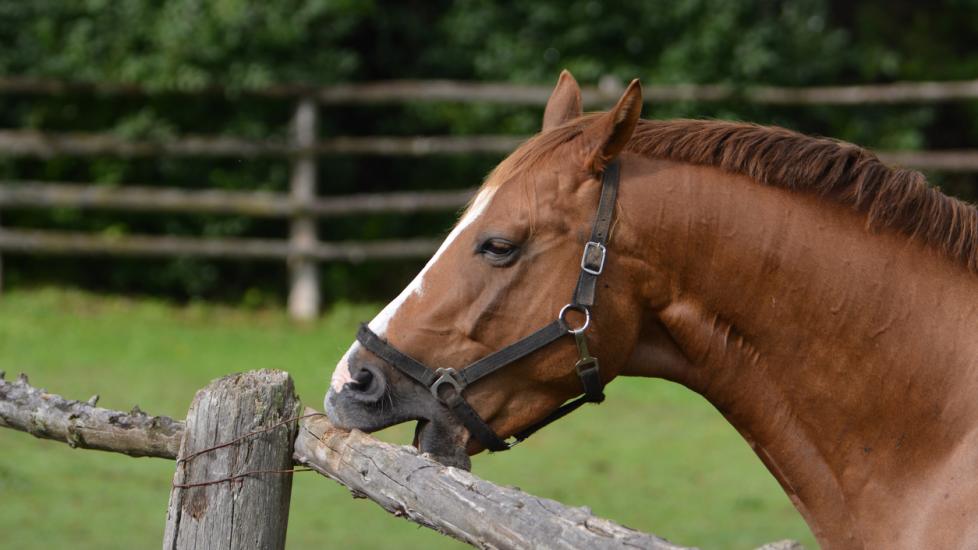Horse Cribbing
What Is Horse Cribbing?
Cribbing is a behavior exhibited by horses in which they grasp onto a solid object with their incisors (front teeth), contract their neck, and pull back, while simultaneously sucking air into their esophagus. They often make a characteristic grunting sound during this process.
Cribbing is categorized as a stereotypical behavior, which is a behavior that is an apparently functionless, repetitive activity. Other stereotypical behaviors include stall-pacing, weaving, pawing, and headshaking. Other names for cribbing include “crib-biting” and “windsucking.”
Cribbing behavior is well-documented in domestic horses, occurring in 5-15% of the general horse population. The rate of occurrence varies by breed. The frequency of cribbing in Thoroughbreds is close to 15%, Arabians closer to 6%, and Standardbreds almost 0%. These breed differences may support the notion that there is a genetic component to cribbing; however, a specific gene has not been detected. Cribbing has also been seen in wild horses, like the Przewalski horses, when they are kept in captivity, but it has not been observed in wild, free-ranging horses.
Is Cribbing Harmful to Horses?
Cribbing can lead to a handful of unwanted side effects. Horses that crib may be at an increased risk for colic and gastric ulcers, though an exact cause-and-effect relationship has not been established.
Horses that crib tend to lose weight and have an overall poor body condition. This is because they spend a large portion of their time and energy on this functionless behavior. Cribbing causes excessive wear on a horse’s teeth. However, in only the most severe cases does it cause detriment to the horse. Other adverse effects include:
- Development of abnormal neck musculature
- Arthritis in the temporohyoid joint
- Damage to property the horse cribs on (i.e., stalls, water/feed troughs)
- Negative stigma around horses that crib—it used to be thought that one horse will learn to crib by watching another horse crib, but this has not been proven
Why Do Horses Crib?
It is not well understood why horses crib, but there are a few plausible theories.
One theory is that stereotypical behaviors, like cribbing, occur as a stress response. Some studies have shown higher blood cortisol levels (a stress hormone) in horses that crib than horses that don’t, but the clinical significance is unknown. Additionally, when animals are prevented from doing a highly motivated innate behavior, they may develop “frustration-related” stress that manifests as a stereotypical behavior.
Other studies have shown that feeding infrequent, highly palatable (tasty) meals are associated with a four-fold increase in cribbing. This type of feeding may cause an acidic pH in the stomach and so horses crib to produce more saliva. Highly palatable meals may also create a calming effect that induces the cribbing behavior. Opioid blocking drugs have been shown to decrease the occurrence of the behavior.
In addition to these theories, it is also necessary to consider the temperament or personality of individual horses. The exact cause of cribbing behavior is likely multifactorial, consisting of a combination of genetic, environmental, and husbandry factors.
How Do You Stop a Horse from Cribbing?
Once a horse has started cribbing, it is likely to develop into a permanent behavior. Efforts to stop the behavior should be taken as soon as possible for the best chance at successfully stopping the behavior.
Previously, deterrent mechanisms like cribbing collars, hog rings placed in front of the mouth, and shock collars or fences were recommended to stop the behavior. However, we now know that these methods used to “punish” are not foolproof and can actually make the matter worse. Hog rings are not recommended by the American Association of Equine Practioners for welfare reasons.
If a cribbing collar is used, it must fit properly so as not create rub sores. Cribbing collars works by applying an uncomfortable pressure when the horse tries to crib. Preventing the horse from cribbing through negative reinforcement can make the horse want to do it more.
A surgery called a modified Forssell’s technique was used to prevent cribbing by removing some of the horse’s neck muscles, but again, this is no longer recommended. It wasn’t very successful and had some complications. Though not routinely performed, there is a surgery that can be done to close the epiploic foramen and prevent the most severe consequence to cribbing, an epiploic foramen entrapment.
Stall toys, like the Jolly Ball or other toys where the horse can lick may decrease cribbing slightly. Surprisingly, increased exercise actually increased cribbing behavior.
Current research shows that the best way to decrease cribbing is to reduce concentrates and sweet feeds, as well as increase turnout time and maximize forage and grazing time. Additionally, providing a feed delivery source where the horse must activate it to get small amount of feed out more frequently has also been helpful in cribbing reduction. Rubber cribbing boards may also be used as a replacement surface for the horse to crib on yet not damage property or his teeth.
When managing cribbing behavior, it is imperative to have a full health screening of the horse done to look for and treat any underlying or concurrent medical conditions. It is recommended to have a gastroscope performed to look for ulcers and then treat them appropriately if detected.
References
- Houpt, K. American College of Veterinary Internal Medicine Forum. Relationship of Cribbing to Food Intake. June 2019
- Archer DC, et al. Equine Veterinary Journal. Risk factors for epiploic foramen entrapment colic in UK horse population: a prospective case-control study. January 2010
- Malamed R, et al. Equine Veterinary Journal. Retrospect evaluation of crib-biting and windsucking behaviors and owner-perceived behavioral traits as risk factors for colic in horses. 2010
- Mills et al. International Veterinary Information Service. Weaving, Headshaking, Cribbing and Other Stereotypies. December 2005.
- Young, A. UC Davis Veterinary Medicine Center for Equine Health. Cribbing. June 2021
- Whisher, L. et al. Applied Animal Science Behavior. Effects of environmental factors on cribbing activity by horses. November 2011
Featured Image: iStock.com/Carol Hamilton
